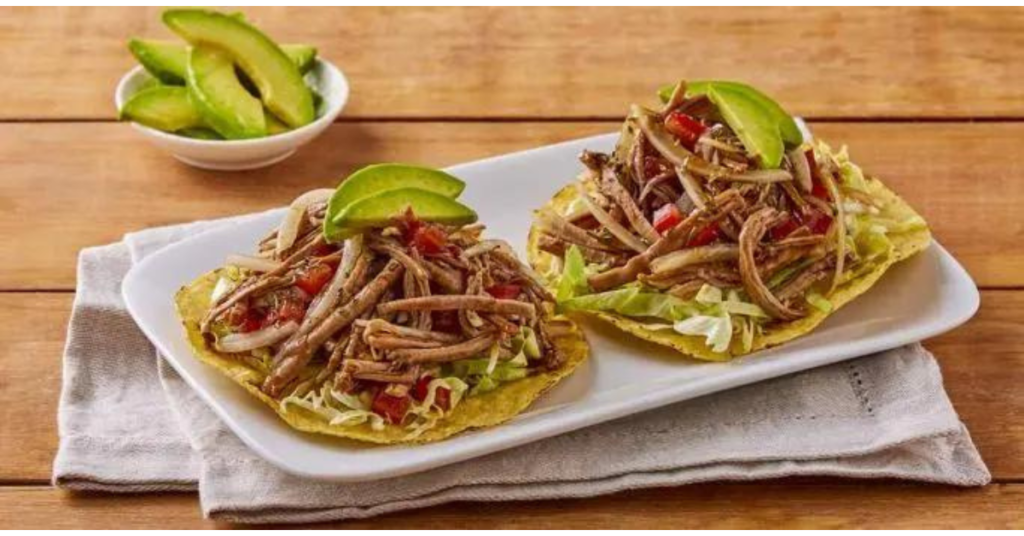Salpicón de Res is a celebrated dish in Latin American cuisine, known for its vibrant mix of flavors, textures, and cultural significance. This refreshing shredded beef salad, often paired with a tangy dressing and an array of fresh vegetables, embodies the culinary traditions of countries such as Mexico, Guatemala, and Colombia. In this in-depth exploration, we will delve into the origins, cultural relevance, regional variations, and preparation methods of Salpicón de Res. We’ll also provide a detailed recipe and tips for making this delightful dish at home.
Origins and Historical Background
The term “salpicón” is derived from the Spanish verb “salpicar,” meaning “to splash” or “to sprinkle,” which refers to the dish’s traditional method of combining various ingredients into a flavorful, unified whole. The concept of salpicón, initially a Spanish culinary creation, involved mixing meats or seafood with acidic elements like vinegar, along with herbs and spices. As Spanish colonizers and explorers brought their culinary traditions to the Americas, salpicón evolved, incorporating local ingredients and flavors.
In Latin America, salpicón adapted to regional tastes and available ingredients, resulting in different versions across the continent. Salpicón de Res, specifically, is a variation that features shredded beef as its central ingredient. This adaptation reflects both the Spanish influence and the diverse culinary traditions of Latin American countries.
Cultural Significance
Salpicón de Res holds a special place in the culinary traditions of Latin America. It is more than just a dish; it is a symbol of family, community, and celebration. Its versatility and refreshing nature make it a popular choice for gatherings, festive occasions, and everyday meals.
Mexico
In Mexico, Salpicón de Res is a staple, especially during warmer months. The dish is celebrated for its light and invigorating qualities, making it ideal for summer. It is often served at family gatherings, fiestas, and as a casual meal. In Mexican cuisine, Salpicón de Res is typically accompanied by tostadas or used as a filling for tacos, reflecting the country’s love for versatile and flavorful dishes.
Guatemala
Guatemala’s version of Salpicón de Res features additional ingredients that highlight the country’s unique culinary influences. Guatemalan Salpicón often includes mint, hard-boiled eggs, and citrus-based dressings. It is commonly served with rice or tortillas, making it a hearty and satisfying option. This version reflects Guatemala’s blend of indigenous and Spanish culinary traditions, creating a dish that is both flavorful and culturally significant.
Colombia
In Colombia, Salpicón de Res takes on a slightly different form, often resembling a cold beef salad. The Colombian version includes a variety of vegetables and a vinaigrette made from vinegar, oil, and mustard. It is particularly popular in coastal regions, where the dish’s light and refreshing nature complements the tropical climate. Colombian Salpicón de Res is a testament to the country’s diverse culinary landscape and its emphasis on fresh, vibrant ingredients.
Key Ingredients and Their Role
Salpicón de Res is characterized by its use of tender shredded beef, fresh vegetables, and a tangy dressing. The following sections provide a detailed overview of the key ingredients and their role in creating the perfect Salpicón de Res.
Beef Selection
The choice of beef is crucial to achieving the desired texture and flavor in Salpicón de Res. The following cuts are commonly used:
- Flank Steak: Known for its rich flavor and fibrous texture, flank steak is a popular choice. It becomes tender when cooked slowly and is easy to shred.
- Brisket: This cut is well-marbled, resulting in a juicy and flavorful final product. It is also suitable for slow cooking and shredding.
- Chuck Roast: A more economical option, chuck roast is ideal for slow cooking. It becomes tender and flavorful, making it a good choice for Salpicón de Res.
The beef is typically simmered in a broth with aromatics until tender, then shredded into thin strips. This process ensures that the meat is flavorful and easy to incorporate into the salad.
Vegetables and Herbs
The vegetables and herbs used in Salpicón de Res contribute to the dish’s refreshing and vibrant flavor profile. Common ingredients include:
- Tomatoes: Fresh, juicy tomatoes add a burst of color and sweetness to the salad.
- Onions: Finely chopped onions provide a sharp contrast to the richness of the beef. Red or white onions are commonly used.
- Cilantro: This herb adds a fresh, herbaceous note that complements the other ingredients.
- Radishes: Radishes add a peppery crunch that enhances the overall texture of the dish.
- Avocado: Optional, but highly recommended for its creamy texture and rich flavor.
Additional ingredients may include bell peppers, cucumbers, or tropical fruits like mango or pineapple, depending on regional variations and personal preferences.
Dressing
The dressing is a crucial component of Salpicón de Res, providing the tangy and zesty flavor that ties the dish together. The traditional Mexican dressing typically includes:
- Lime Juice: Fresh lime juice provides a bright, citrusy flavor that balances the richness of the beef.
- Olive Oil: Adds richness and helps to emulsify the dressing.
- Salt and Pepper: Enhances the natural flavors of the ingredients.
- Oregano: Adds a subtle earthiness that complements the other flavors.
In some variations, additional ingredients like vinegar, mustard, or a touch of sugar may be used to balance the acidity and enhance the overall flavor.
Step-by-Step Recipe: Traditional Mexican-Style Salpicón de Res
This recipe provides a detailed guide to preparing a classic Mexican-style Salpicón de Res. It includes instructions for cooking the beef, preparing the vegetables, and assembling the salad.
Ingredients
For the beef:
- 1 ½ pounds of flank steak, brisket, or chuck roast
- 1 onion, halved
- 2 cloves of garlic
- 2 bay leaves
- 1 teaspoon of salt
- Water (enough to cover the beef)
For the salad:
- 2 large tomatoes, diced
- 1 small red onion, finely chopped
- 1 bunch of cilantro, chopped
- 4 radishes, thinly sliced
- 1 avocado, diced (optional)
- 1 jalapeño, finely chopped (optional)
- Salt and pepper to taste
For the dressing:
- ¼ cup of freshly squeezed lime juice (about 2-3 limes)
- ¼ cup of olive oil
- 1 teaspoon of dried oregano
- Salt and pepper to taste
Instructions
- Cook the Beef:
- In a large pot, combine the beef, onion, garlic, bay leaves, and salt. Add enough water to cover the beef and bring to a boil over medium-high heat.
- Once boiling, reduce the heat to low and simmer for about 1 ½ to 2 hours, or until the beef is tender and easily shredded with a fork.
- Remove the beef from the pot and allow it to cool slightly. Once cool enough to handle, shred the beef into thin strips using two forks. Set aside.
- Prepare the Vegetables:
- While the beef is cooking, prepare the vegetables. Dice the tomatoes, finely chop the red onion and cilantro, and slice the radishes thinly. If using avocado and jalapeño, dice them as well.
- Make the Dressing:
- In a small bowl, whisk together the lime juice, olive oil, oregano, salt, and pepper until well combined.
- Assemble the Salad:
- In a large mixing bowl, combine the shredded beef with the diced tomatoes, chopped onion, cilantro, and radishes (and avocado and jalapeño if using).
- Pour the dressing over the salad and toss until all the ingredients are well coated.
- Serve:
- Season the salad with additional salt and pepper to taste. Serve chilled or at room temperature with tostadas, tortillas, or as a filling for tacos.
Tips for Perfecting Salpicón de Res
- Quality Ingredients: The success of Salpicón de Res relies on the freshness and quality of its ingredients. Use ripe tomatoes, fresh herbs, and high-quality beef for the best results.
- Balancing Flavors: Taste the dressing before adding it to the salad and adjust the seasoning as needed. Aim for a balance between the acidity of the lime juice and the richness of the olive oil.
- Chill Before Serving: Salpicón de Res is best served chilled or at room temperature. Allowing the salad to sit for a short time after assembling can enhance the flavors as they meld together.
Conclusion
Salpicón de Res is a vibrant and versatile dish that embodies the rich culinary traditions of Latin America. With its tender shredded beef, fresh vegetables, and tangy dressing, it offers a refreshing and satisfying meal that is both culturally significant and delicious. Whether enjoyed as a light summer salad, a hearty filling for tacos, or a centerpiece at a festive gathering, Salpicón de Res showcases the best of Latin American cuisine.
Exploring the history and regional variations of Salpicón de Res reveals the dish’s adaptability and enduring appeal. From its Spanish origins to its diverse expressions across Latin America, Salpicón de Res represents a fusion of flavors and traditions that continue to delight and inspire. By following the detailed recipe and tips provided, you can create an authentic and flavorful Salpicón de Res that honors its rich heritage while adding your personal touch.







